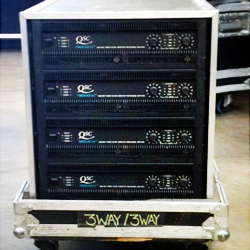
Q.) More on power specs: what do “FTC” and “EIA” mean?
A.) Those are currently the two most common ways of measuring amplifier power. One common method years ago was the IHF standard, which involved measuring an amp’s maximum RMS voltage, just at the onset of clipping, across a load, such as 8, 4, or 2 ohms.
The tricky part was that it was measured with a 1 kHz sine wave repeated pulsed on fully for 20 milliseconds, then 480 milliseconds at 20 dB down (or 1 percent power, in other words). Consequently the spec measured headroom, and not continuous power, causing many wimpy amps to boast impressive numbers as power specs.
Thankfully, the IHF spec is almost completely gone now. A somewhat more rigorous method is the EIA standard, which requires measurement with a constant-amplitude single mid-band frequency. Most manufacturers choose 1 kHz. The amp drives the sign wave into a specified load resistance, such as 8, 4, or 2 ohms, and the gain is turned up until the amp’s clipping point is reached.
The clipping point is defined as the level at which the total harmonic distortion (THD) of the sine wave reaches a specified figure, such as 0.05, 0.1, or 1 percent. This THD figure is only a reference—it describes a repeatable means of arriving at the clipping point. Don’t confuse it with the amp’s actual THD performance. At this clipping point, the RMS voltage is used to calculate the power delivered into the load resistance.
One shortcoming of the EIA spec, aside from its limited frequency spectrum, is that it allows a manufacturer to drive and put under load only one channel at a time. Not all manufacturers take advantage of this loophole, which can be used to conceal a weak power supply.
Far more rigorous is the FTC spec, which has been around since May 1974. Established as a consumer protection measure for home entertainment equipment by the Federal Trade Commission (FTC), an agency of the U.S. government, the FTC spec requires measurement using a sine wave over a specified range of frequencies, instead of the single mid-band frequency required by EIA or IHF
Usually the frequency range used is 20 Hz to 20 kHz, although it can be different as long as it is specified. Also, all channels of the amplifier are driven and put under load at the same time, which would tend to expose any weak power supply.
But the most demanding aspect of an FTC spec has to be the preconditioning: 60 minutes at 1/3rd of full power, all channels driven into specified load resistances, with a 1 kHz sine. Followed by 5 minutes at full power, all channels, specified loads, 1 kHz. The amp cannot thermal, shut down, current limit, or otherwise quit during this time.
